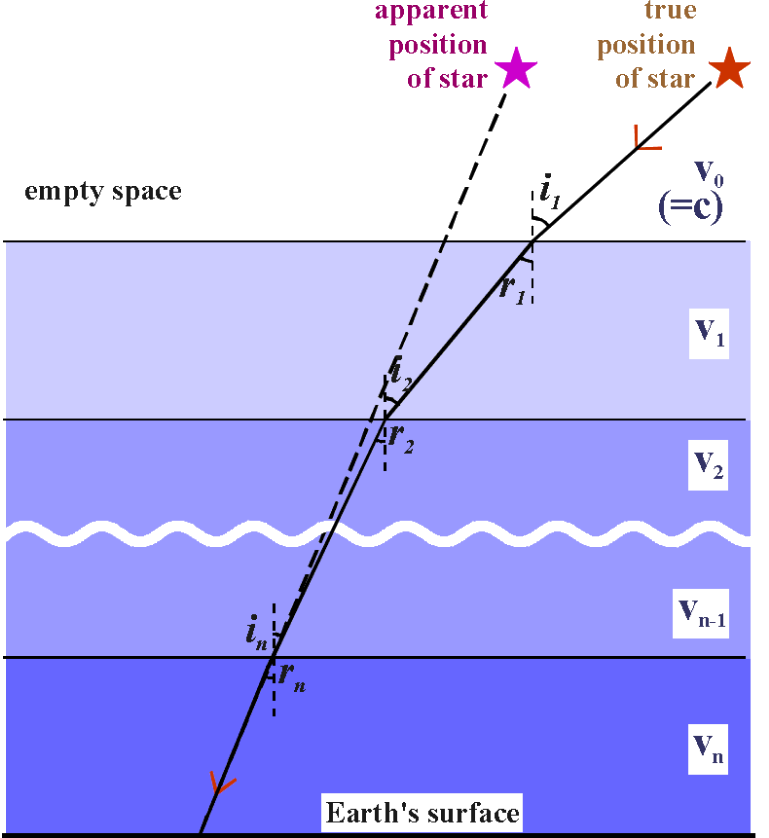-
"الفلك الموضعي"
- مقدمة
- الكرة الأرضية
- هندسة المثلثات الكروية
- ملاحظات حول الهندسة الكروية
- إحداثيات أفقية "alt-az"
- إحداثيات استوائية "HA-dec"
- إحداثيات استوائية "RA-dec"
- الزمن النجمي
- الانتقال بين أفقي و استوائي
- إحداثيات مجرية
- إحداثيات بروجية
- الانتقال بين بروجي و استوائي
- حركة الشمس و ضبط الوقت
- القمر
- الإنكسار الجوي
- شروق و غروب الشمس، الشفق
- اختلاف المنظر المركزي اليومي
- اختلاف المنظر الموسمي
- الزيغ
- المبادرة و الترنح :اضطراب محور الأرض
- تقاويم
- الامتحان الأخير
- الإحداثيات الفلكية، خضر الأحمد
- الحركة الظاهرية للنجوم (تفاعلي)
- الأقطاب السماوية (تفاعلي)

الانكسار الجوي
{Note: If your browser does not distinguish between "a,b" and "α, β" (the Greek letters "alpha, beta") then I am afraid you will not be able to make much sense of the equations on this page.}
The apparent position of an object in the sky may be changed by several different physical effects. One of these is refraction.
The speed of light changes as it passes through a medium such as air. We define the refractive index of any transparent medium as 1/v, where v is the speed of light in that medium.
The speed of light in air depends on its temperature and its pressure, so the refractive index of the air varies in different parts of the atmosphere.
Make a simple model of the atmosphere as n layers of uniform air above a flat Earth, with a different velocity of light vi for each layer (i from 1 to n). Apply Snell's Law of Refraction at each boundary.

At the first boundary, sin(i1) / sin(r1) = v0
/ v1 .
At the next boundary, sin(i2)
/ sin(r2) = v1 / v2 , and so on.
But, by simple geometry, r1 = i2, r2 = i3 and so on.
So we have
sin(i1) = (v0 /
v1) sin(r1) =
(v0 / v1) sin(i2) =
(v0 / v1) (v1 / v2)
sin(r2) =
(v0 / v2) sin(r2) =
.......... =
(v0 / vn) sin(rn)
In other words, the refractive indices of the intervening layers all cancel out. The only thing that matters is the ratio between v0(which is c, the speed of light in vacuum) and vn (the speed in the air at ground level).
Now rn is the apparent zenith distance of the star, z',
and i1 is its true zenith distance, z.
So sin(z) = (v0 / vn)
sin(z').
Refraction has no effect if a star is at the zenith (z=0). But at any other position, the star is apparently raised; the effect is greatest at the horizon.
Define the angle of refraction R by R = z - z'. Rearrange this as z = R + z'. Then sin(z) = sin(R) cos(z') + cos(R) sin(z').
We assume R will be small, so, approximately, sin(R) = R (in radians), and cos(R) = 0.
Thus, approximately,
sin(z)
= sin(z') + R cos(z').
Divide throughout by sin(z') to get
sin(z)/sin(z') = 1 + R/tan(z')
which is to say,
v0/vn
= 1 + R/tan(z').
So we can write
R
= (v0/vn - 1) tan(z')
We write this
as
R = k tan(z')
where
k = (v0/vn - 1)
Here v0 is c, the velocity of light in a
vacuum, which is constant.
But vn depends on
the temperature and pressure of the air at ground level.
At
"standard" temperature (0°C = 273K) and pressure (1000
millibars),
k = 59.6 arc-seconds.
The formula in the Astronomical Almanac is
k
= 16.27" P/(273+T)
where P is in millibars, and T is in °C.
تمرين:
How much will the star’s image be shifted by atmospheric refraction, and in which direction?
What will be the star’s Right Ascension and declination, corrected for refraction?
الحل:
How much will the star’s image be shifted by atmospheric refraction, and in which direction?
What will be the star’s Right Ascension and declination, corrected for refraction?
At large zenith distances, this model is inadequate. The amount of refraction near the horizon is actually determined observationally. At standard temperature and pressure, refraction at the horizon (horizontal refraction) is found to be 34 arc-minutes.
- القمر
ترجمة قتيبة أقرع
- شروق و غروب الشمس